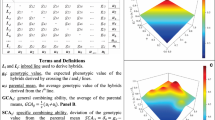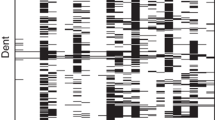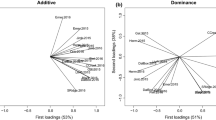Abstract
Best linear unbiased prediction (BLUP) has been found to be useful in maize (Zea mays L.) breeding. The advantage of including both testcross additive and dominance effects (Intralocus Model) in BLUP, rather than only testcross additive effects (Additive Model), has not been clearly demonstrated. The objective of this study was to compare the usefulness of Intralocus and Additive Models for BLUP of maize single-cross performance. Multilocation data from 1990 to 1995 were obtained from the hybrid testing program of Limagrain Genetics. Grain yield, moisture, stalk lodging, and root lodging of untested single crosses were predicted from (1) the performance of tested single crosses and (2) known genetic relationships among the parental inbreds. Correlations between predicted and observed performance were obtained with a delete-one cross-validation procedure. For the Intralocus Model, the correlations ranged from 0.50 to 0.66 for yield, 0.88 to 0.94 for moisture, 0.47 to 0.69 for stalk lodging, and 0.31 to 0.45 for root lodging. The BLUP procedure was consistently more effective with the Intralocus Model than with the Additive Model. When the Additive Model was used instead of the Intralocus Model, the reductions in the correlation were largest for root lodging (0.06–0.35), smallest for moisture (0.00–0.02), and intermediate for yield (0.02–0.06) and stalk lodging (0.02–0.08). The ratio of dominance variance (v D) to total genetic variance (v G) was highest for root lodging (0.47) and lowest for moisture (0.10). The Additive Model may be used if prior information indicates that VD for a given trait has little contribution to VG. Otherwise, the continued use of the Intralocus Model for BLUP of single-cross performance is recommended.
Similar content being viewed by others
References
Bernardo R (1994) Prediction of maize single-cross performance using RFLPs and information from related hybrids. Crop Sci 34:20–25
Bernardo R (1995) Genetic models for predicting maize single-cross performance in unbalanced yield trial data. Crop Sci 35:141–147
Bernardo R (1996) Best linear unbiased prediction of maize single-cross performance. Crop Sci 36:50–56
Chang HLA (1988) Studies on estimation of genetic variances under non-additive gene action. PhD thesis, University of Illinois, Urbana-Champaign (Diss Abstr 50–03B834)
Emik LO, Terrill CE (1949) Systematic procedures for calculating inbreeding coefficients. J Hered 40:51–55
Hallauer AR, Miranda JB Fo (1981) Quantitative genetics in maize breeding. Iowa State University Press, Ames
Henderson CR (1984) Applications of linear models in animal breeding. University of Guelph, Guelph, Ontario, Canada
Henderson CR (1985) Best linear unbiased prediction of nonadditive genetic merits in noninbred populations. J Anim Sci 60: 111–117
Robson DS, Powers L, Urquahart NS (1967) The proportion of genetic deviates in the tails of a normal population. Der Zucht 37:205–216
Stuber CW, Cockerham CC (1966) Gene effects and variances in hybrid populations. Genetics 54:1279–1286
Author information
Authors and Affiliations
Additional information
Communicated by P. M. A. Tigerstedt
Rights and permissions
About this article
Cite this article
Bernardo, R. Testcross additive and dominance effects in best linear unbiased prediction of maize single-cross performance. Theoret. Appl. Genetics 93, 1098–1102 (1996). https://doi.org/10.1007/BF00230131
Received:
Accepted:
Issue Date:
DOI: https://doi.org/10.1007/BF00230131




